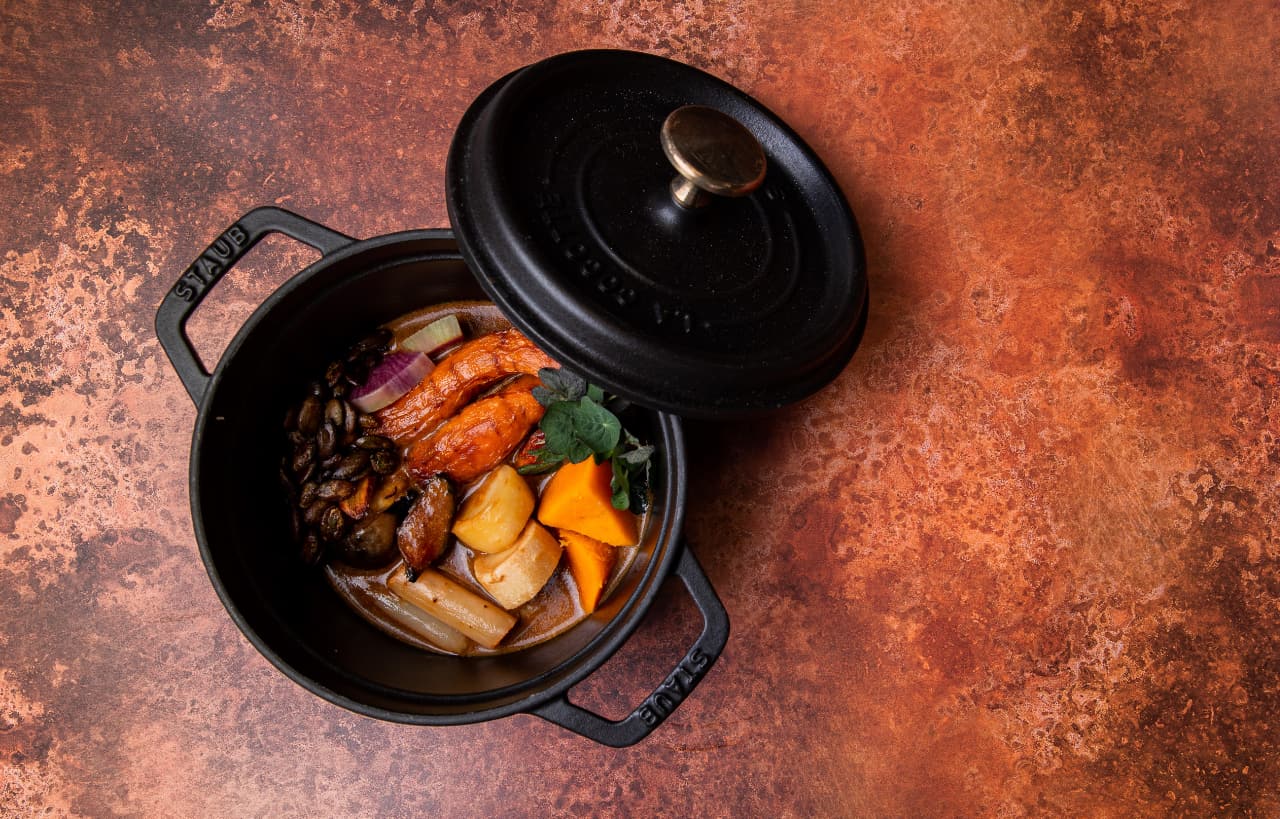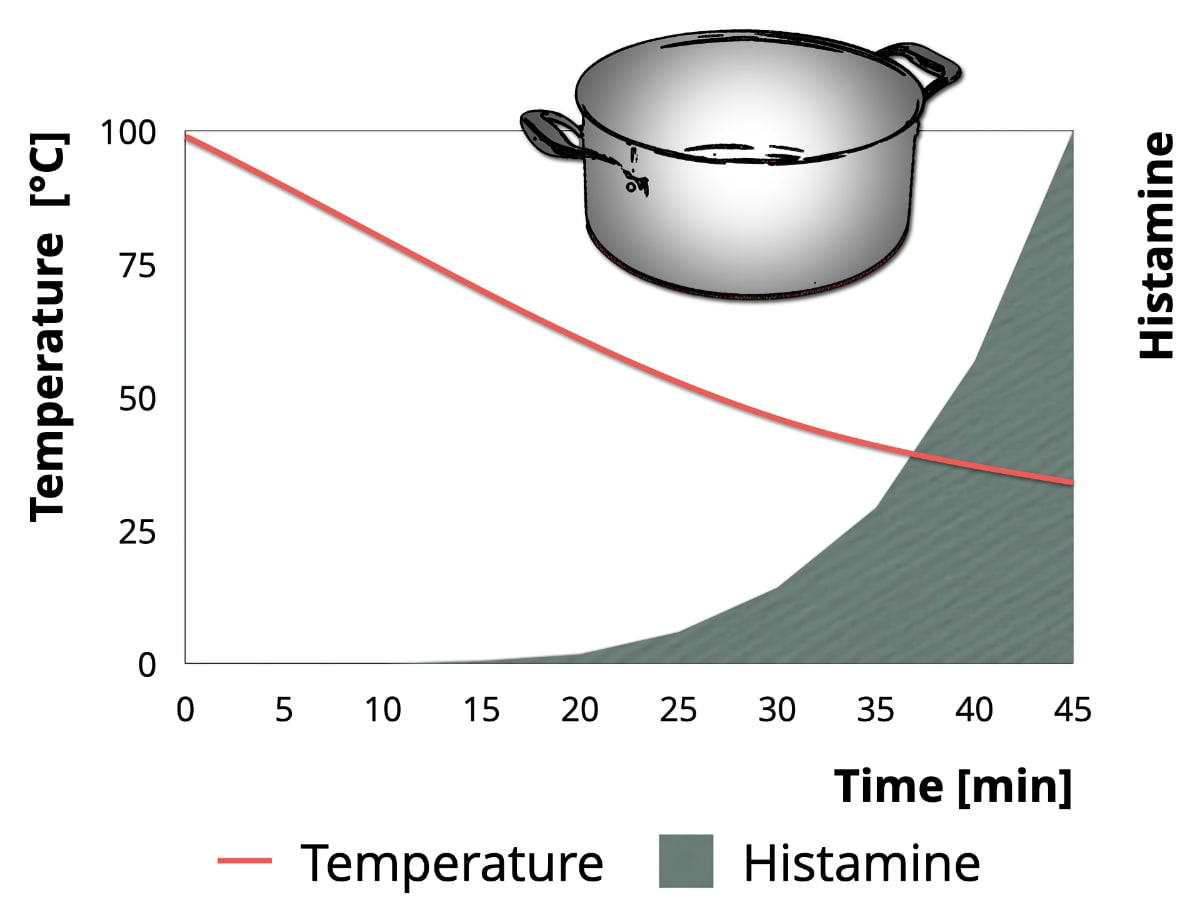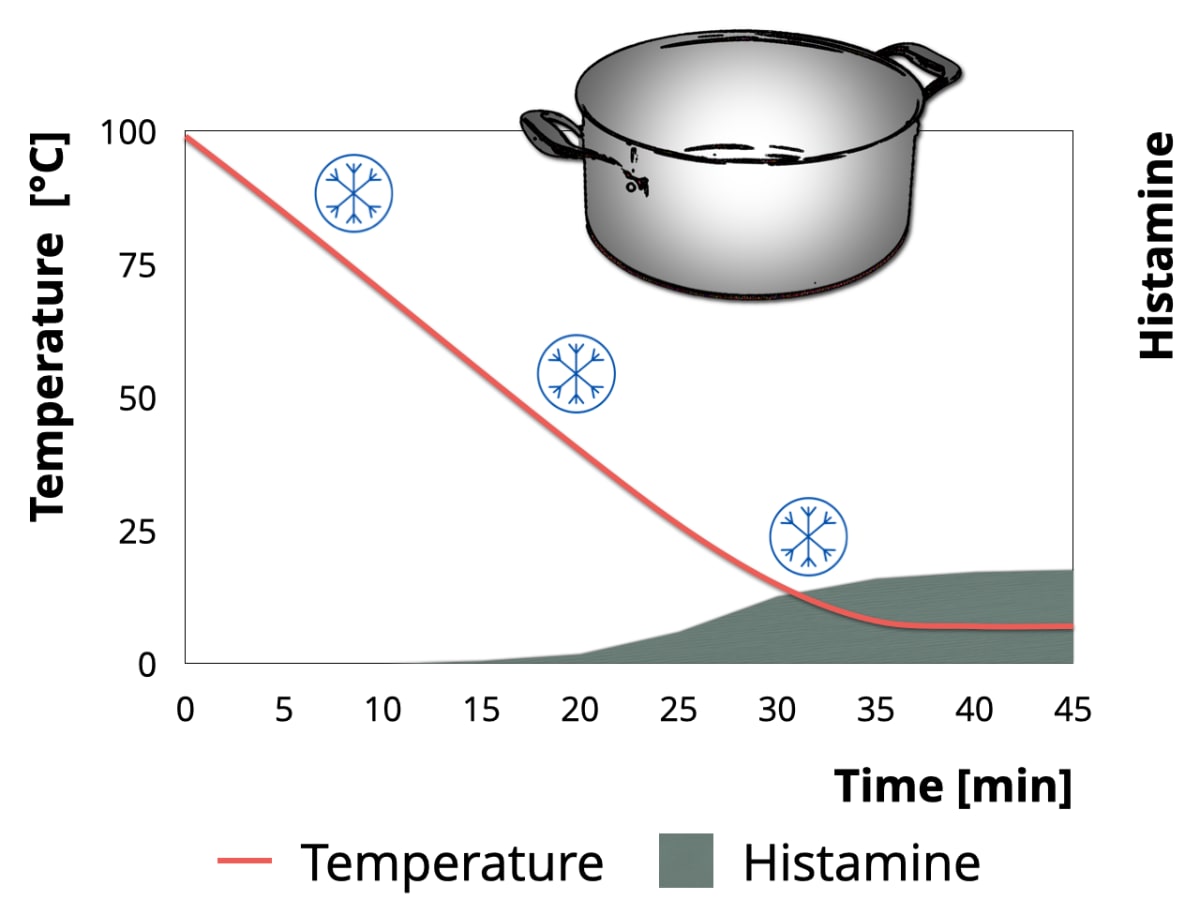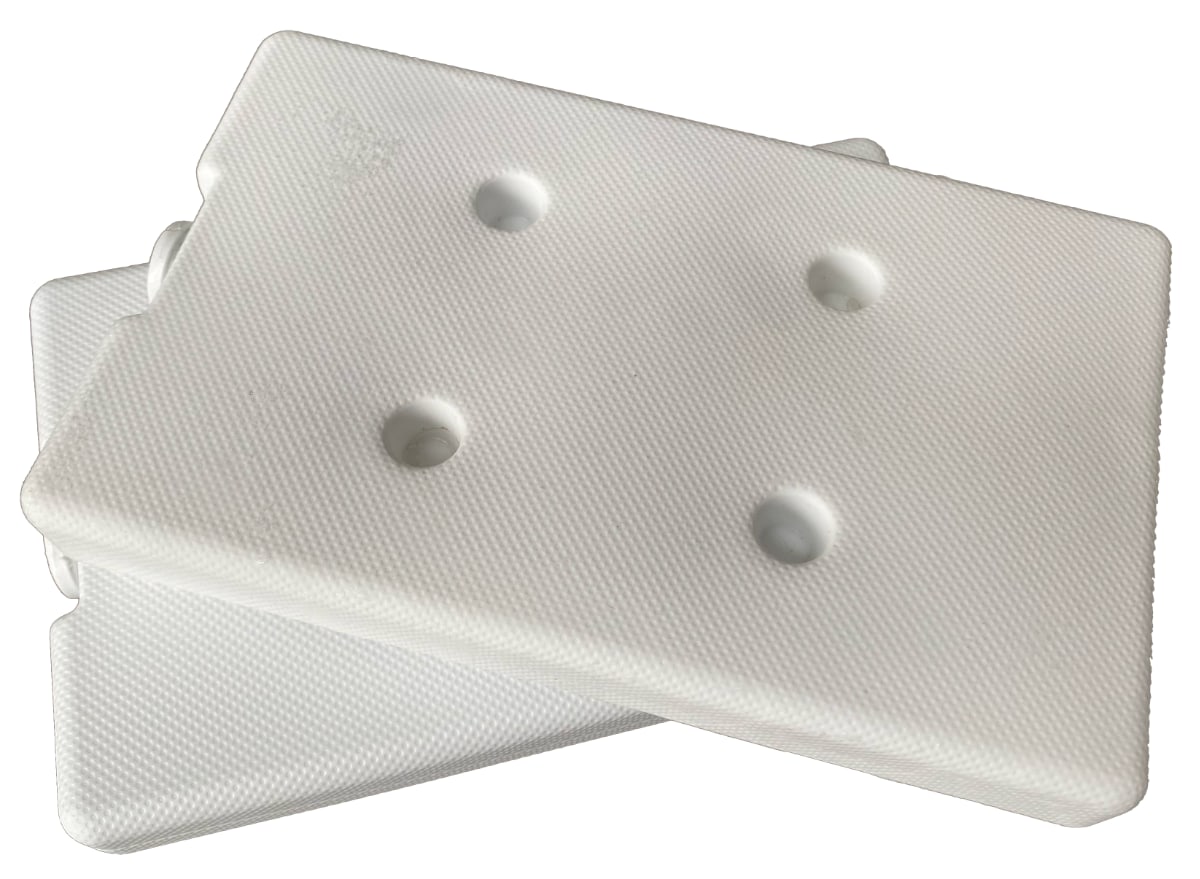Histamine intolerance and reheated dishes
02/10/2021 Food Intolerances
Fresh foods usually don't contain histamine and other biogenic amines, those are primarily formed during the microbial decomposition of certain amino acids in the food. The degree to which a meal is contaminated with histamine mainly depends on the following questions:
Histamine-producing germs thrive in warm environments, therefore proper handling and compliance with certain rules can help to minimize the build-up of histamine. In the following, we explain the backgrounds and tell you why reheated foods have the highest potential of histamine contamination.

Fresh meat, poultry or fish contain a high proportion of the amino acid histidine. On these foods you can almost always find germs that have the ability to break down histidine into histamine with the enzyme histidine decarboxylase. Therefore, these foods bear a higher risk than, say, vegetables, where these germs are rarely present in large numbers. This factor is very important for the evaluation of foods in our app Food Intolerances.
The growth of histamine producing bacteria can only be inhibited at sufficiently low temperatures. Temperature abuse can cause an explosive growth of germs followed by a ramped-up production of histidine decarboxylase. This enzyme is also active at low temperatures, although at a decreased rate. Therefore, the histamine content of foods can increase while refrigerated, highlighting the importance of continuous cooling. Once histamine formation occurrs, the contamination can't be removed again, because histamine is heat-stable and won't be inactivated during cooking.
Not all bacteria produce histamine – the concentration of biogenic amines remains low in the absence of pathogenic germs.
Boiling creates a sterile environment inside the cookware, because temperatures of 74–100 °C (165–212 °F) kill off practically all germs and spoilage enzymes. This effect can be used for making preserves, where hermetically sealed containers are pasteurized to eliminate pathogens. As long as the container remains sealed under exclusion of air, micro-organisms are prevented from growing and preserved foods stays nonperishable.
However, there are many possible sources of contamination while handling food in the kitchen under non-sterile conditions. Pots don't have an air-tight seal that prevents the growth of micro-organisms. When the pot stays without lid for an extended period of time, germs from the surrounding environment can get into it.
Some germs that can cause food poisoning are able to form extremely heat-resistant spores. These cannot even be eliminated by boiling. Decreasing temperatures (below 158 °F) facilitate the repopulation with these histamine-producing germs which eventually causes a rise in the histamine level (see figure 1).

▲ Figure 1: Histamine formation in insufficiently cooled dishes.
In many cases, prepared dishes are stored outside the refrigerator longer than necessary, mostly not to stress the cooling circuit with hot items, but that is a huge mistake. Large pots only cool down very slowly and remain in the critical temperature window of 30–60 °C (86–140 °F) for a long time – these are ideal conditions for the explosive growth of micro-organisms. The microbial growth and enzyme activity only slows down at sufficiently low temperatures of 7 °C (44.6 °F) and below. Therefore, the goal should be to reach these temperatures as quickly as possible (see figure 2).

▲ Figure 2: Significantly lower histamine formation with adequate cooling.
There are certain dangers when eating in a restaurant, because many foods are prepared ahead and then reheated in order to deal with a high number of customers. Each failure to comply with rules of food safety and hygiene bears the risk of food-borne illness. The most common mistakes include temperature abuse of critical ingredients, insufficient cooling of pre-cooked foods, long storage at critical temperatures and failure to heat thoroughly. Unfortunately, you have to expect a certain histamine load when eating out, especially in restaurants with buffets.
If food is not heated thoroughly, pathogenic germs are not killed off and can start producing significant amounts of histamine. This danger is especially high when using a microwave oven, because the temperature can be very uneven and cold spots may not reach the necessary temperatures to eliminate all germs. As a consequence, the histamine concentration can quickly reach critical levels for people with histamine intolerance. Only sufficiently long heating and repeated stirring can help to ensure an evenly spread temperature level of at least 74 °C (165 °F) throughout the dish.
If you prepare a dish and want to enjoy the leftovers on the next day, you need to cool them down as quickly as possible (see figure 2). In order to cool down a big pot you can put it into cold water in the sink or cool it with thermal packs from the freezer and then immediately move it into the fridge as soon as the temperature allows it. You should never leave your food out for several hours.

▲ Figure 3: Thermal packs help to quickly cool down a pot without stressing the refrigerator.
Reheating foods multiple times is a risk factor for the build-up of histamine. It is therefore recommended to cook all meals that contain critical ingredients as freshly as possible, and if that is not possible, to divide the meal into individual portions and immediately freeze them.
This blog post was revised on 12/06/2023.
Back to blog
Sources:
A. Naila et al., Control of Biogenic Amines in Food – Existing and Emerging Approaches, Journal of Food Science 75:7 (2010), 139–150
J. Leszczyńska et al., The Histamine Content in Some Samples of Food Products, Czech J. Food Sci. 22:3 (2004), 81–86
I. Altieri et al., European official control of food: Determination of histamine in fish products by a HPLC-UV-DAD method, Food Chemistry 211 (2016), 694–699
Image:
Photo by Edward Howell on Unsplash
- Are there any histamine-producing bacterial strains present?
- Is there appropriate substrate (in form of histidine) for histamine production?
- How fast can the bacteria multiply?
- Are some of the ingredients already pre-contaminated?
- What is the activity of histamine-producing enzymes?
Histamine-producing germs thrive in warm environments, therefore proper handling and compliance with certain rules can help to minimize the build-up of histamine. In the following, we explain the backgrounds and tell you why reheated foods have the highest potential of histamine contamination.

Histamine formation caused by microbial contamination
Fresh meat, poultry or fish contain a high proportion of the amino acid histidine. On these foods you can almost always find germs that have the ability to break down histidine into histamine with the enzyme histidine decarboxylase. Therefore, these foods bear a higher risk than, say, vegetables, where these germs are rarely present in large numbers. This factor is very important for the evaluation of foods in our app Food Intolerances.
Why do we care so much about this topic?
 We have been developing our price-winning "Food Intolerances" app since 2011 and we are happy to share our knowledge with you. Check it out:
We have been developing our price-winning "Food Intolerances" app since 2011 and we are happy to share our knowledge with you. Check it out:
The growth of histamine producing bacteria can only be inhibited at sufficiently low temperatures. Temperature abuse can cause an explosive growth of germs followed by a ramped-up production of histidine decarboxylase. This enzyme is also active at low temperatures, although at a decreased rate. Therefore, the histamine content of foods can increase while refrigerated, highlighting the importance of continuous cooling. Once histamine formation occurrs, the contamination can't be removed again, because histamine is heat-stable and won't be inactivated during cooking.
Not all bacteria produce histamine – the concentration of biogenic amines remains low in the absence of pathogenic germs.
Formation of histamine due to improper cooling
Boiling creates a sterile environment inside the cookware, because temperatures of 74–100 °C (165–212 °F) kill off practically all germs and spoilage enzymes. This effect can be used for making preserves, where hermetically sealed containers are pasteurized to eliminate pathogens. As long as the container remains sealed under exclusion of air, micro-organisms are prevented from growing and preserved foods stays nonperishable.
However, there are many possible sources of contamination while handling food in the kitchen under non-sterile conditions. Pots don't have an air-tight seal that prevents the growth of micro-organisms. When the pot stays without lid for an extended period of time, germs from the surrounding environment can get into it.
Some germs that can cause food poisoning are able to form extremely heat-resistant spores. These cannot even be eliminated by boiling. Decreasing temperatures (below 158 °F) facilitate the repopulation with these histamine-producing germs which eventually causes a rise in the histamine level (see figure 1).

▲ Figure 1: Histamine formation in insufficiently cooled dishes.
In many cases, prepared dishes are stored outside the refrigerator longer than necessary, mostly not to stress the cooling circuit with hot items, but that is a huge mistake. Large pots only cool down very slowly and remain in the critical temperature window of 30–60 °C (86–140 °F) for a long time – these are ideal conditions for the explosive growth of micro-organisms. The microbial growth and enzyme activity only slows down at sufficiently low temperatures of 7 °C (44.6 °F) and below. Therefore, the goal should be to reach these temperatures as quickly as possible (see figure 2).

▲ Figure 2: Significantly lower histamine formation with adequate cooling.
Dangers when eating out
There are certain dangers when eating in a restaurant, because many foods are prepared ahead and then reheated in order to deal with a high number of customers. Each failure to comply with rules of food safety and hygiene bears the risk of food-borne illness. The most common mistakes include temperature abuse of critical ingredients, insufficient cooling of pre-cooked foods, long storage at critical temperatures and failure to heat thoroughly. Unfortunately, you have to expect a certain histamine load when eating out, especially in restaurants with buffets.
Increased danger when heating in the microwave
If food is not heated thoroughly, pathogenic germs are not killed off and can start producing significant amounts of histamine. This danger is especially high when using a microwave oven, because the temperature can be very uneven and cold spots may not reach the necessary temperatures to eliminate all germs. As a consequence, the histamine concentration can quickly reach critical levels for people with histamine intolerance. Only sufficiently long heating and repeated stirring can help to ensure an evenly spread temperature level of at least 74 °C (165 °F) throughout the dish.
How do you prevent the formation of histamine?
If you prepare a dish and want to enjoy the leftovers on the next day, you need to cool them down as quickly as possible (see figure 2). In order to cool down a big pot you can put it into cold water in the sink or cool it with thermal packs from the freezer and then immediately move it into the fridge as soon as the temperature allows it. You should never leave your food out for several hours.

▲ Figure 3: Thermal packs help to quickly cool down a pot without stressing the refrigerator.
Reheating foods multiple times is a risk factor for the build-up of histamine. It is therefore recommended to cook all meals that contain critical ingredients as freshly as possible, and if that is not possible, to divide the meal into individual portions and immediately freeze them.
This blog post was revised on 12/06/2023.
Why do we care so much about this topic?
 We have been developing our price-winning "Food Intolerances" app since 2011 and we are happy to share our knowledge with you. Check it out:
We have been developing our price-winning "Food Intolerances" app since 2011 and we are happy to share our knowledge with you. Check it out:
Share article
Share article
Back to blog
Sources:
A. Naila et al., Control of Biogenic Amines in Food – Existing and Emerging Approaches, Journal of Food Science 75:7 (2010), 139–150
J. Leszczyńska et al., The Histamine Content in Some Samples of Food Products, Czech J. Food Sci. 22:3 (2004), 81–86
I. Altieri et al., European official control of food: Determination of histamine in fish products by a HPLC-UV-DAD method, Food Chemistry 211 (2016), 694–699
Image:
Photo by Edward Howell on Unsplash
![[Blog]](../../rw_common/images/baliza_logo_retina.png)



